As the tires crunched on the gravel paths, the Great Divide Mountain Bike Route (GDMBR) constantly reminded me of the shared journey of countless cyclists. After a year of relative isolation, the allure of this well-trodden path was irresistible, promising a sense of community amidst the vast landscapes. Every cyclist encountered sparked a conversation, and even the mundane act of stocking up on gas station snacks became a joyful acknowledgement of this shared adventure, with store clerks unfazed by cyclists laden with mini donuts and powdered mashed potatoes.
In 2021 alone, I was just one among thousands who embarked on the Great Divide Bike route. My experience was statistically unremarkable, yet the sheer distance of the journey transforms every rider into a seasoned expert. After pedaling 2,700 miles, roughly 1,600 solo and 1,100 alongside my husband, I’ve become intimately acquainted with the nuances of the Divide. I could wax lyrical about the diverse textures of gravel (“chunky and washboarded with a rustic finish”), the beautifully unpredictable Rocky Mountain weather patterns, and the fluctuating availability of the quintessential cyclist’s fuel: the cheeseburger.
If we were to meet around a crackling campfire and your curiosity about the Great Divide bike route was piqued, the advice in this article would be my offering. These insights shaped the mood and rhythm of my own journey, but it’s vital to remember that the Divide has been conquered in virtually every style imaginable. Cyclists of all paces and experience levels, on every type of bike and with varied gear, have traversed this route. So, consider this advice as an invitation to contemplate your own aspirations for this ride, and as practical tips to help you realize them.
Choose Your Direction: Northbound vs. Southbound on the Great Divide Bike Route
The traditional trajectory of the GDMBR is southbound, stretching from Canada to Mexico. The initial appeal is obvious: starting in the mountains and descending towards the desert implies an easier, downhill journey, right? (A playful misconception, as anyone who has ridden it will attest!).
However, a growing contingent of riders, myself included, are embracing the northbound (NOBO) route, starting at Antelope Wells in the south and pedaling towards Canada, akin to salmon swimming upstream. My decision to ride NOBO was partly driven by the timing of the Canadian border reopening to tourists after a prolonged closure.
Initially, my research suggested that a northbound Great Divide bike ride would be daunting. Seasoned bikepackers cautioned about prevailing north-to-south winds and steeper climbs on the southern side of the route. Headwinds and relentless, unrideable ascents sounded like significant obstacles.
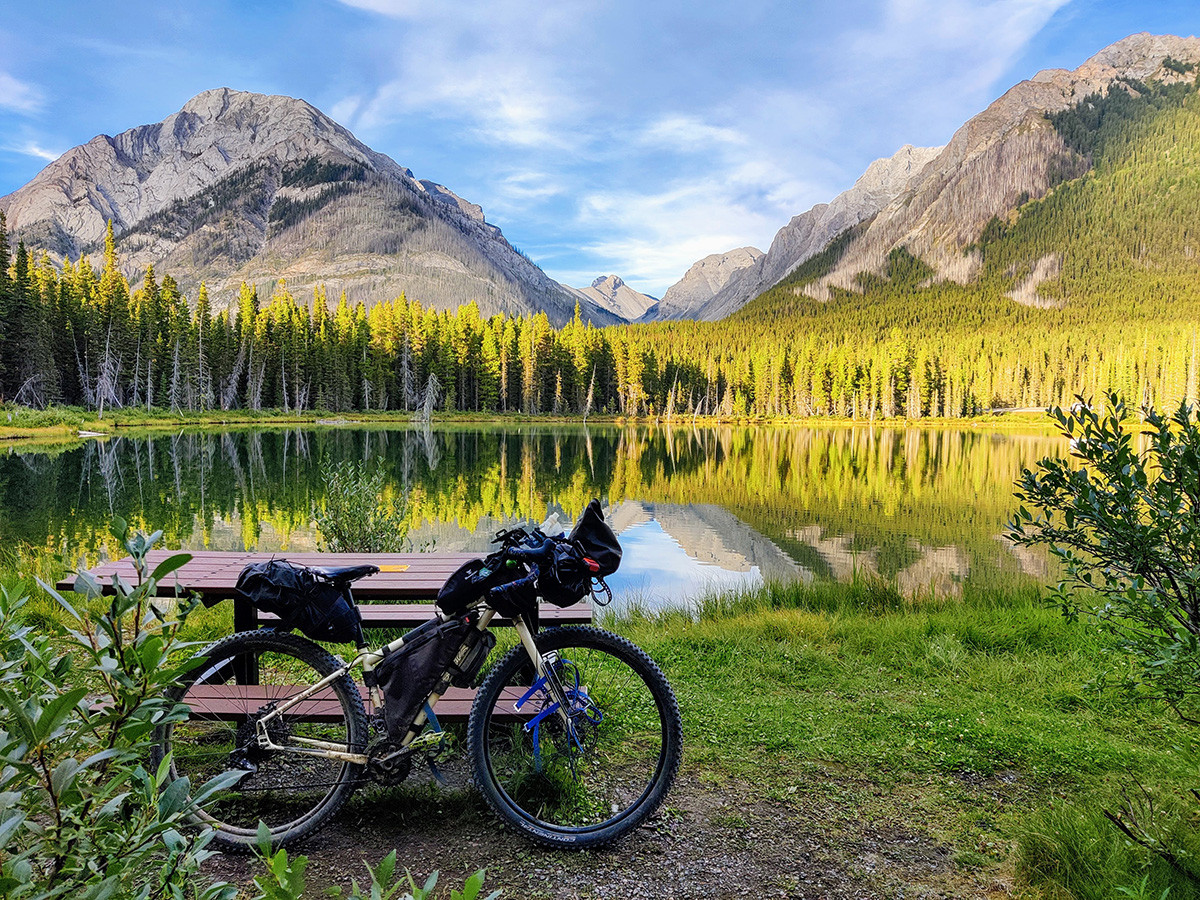 Alissa
Alissa
Alissa’s last night on the Divide at Buller Lake, Alberta, near the starting point for many southbounders.
Alissa Bell
In reality, my northbound experience was far from harrowing. While Wyoming and southern Montana did present stretches of challenging headwinds, and some climbs certainly required pushing my bike, these were balanced by extended periods of favorable weather and gentler gradients. Conversations with southbound riders revealed that they too encountered their share of headwinds and steep climbs. It appears that for non-racers, the purported specific difficulties of northbound travel are overshadowed by the inherent variability of conditions across the entire route.
Opting for a northbound Great Divide bike adventure offers distinct advantages, even in years with open borders. A late May or early June start allows a longer window before snow becomes a concern in the high mountains of southern Colorado. The demanding and remote roads of New Mexico ensure that the longest food and water carries and the toughest climbs are tackled early in the journey. Furthermore, a northbound ride culminates in the breathtaking Canadian Rockies, offering a spectacular finish.
The social dynamic of riding northbound is also unique. While you might encounter another northbounder every few days, southbound riders become a frequent sight, especially during peak season. This creates a lively sense of shared endeavor, though most encounters are brief and fleeting. Whether this is a pro or con depends on your personal riding style.
Perhaps the most significant hurdle of a northbound Great Divide bike ride was mentally reversing all the directions and waypoints. Thankfully, the Adventure Cycling Association provides northbound versions of their maps and GPX data, but resources like the McCoy Guidebook and many riders’ journals are primarily oriented towards southbound travel. However, this mental recalibration can be a positive aspect, deepening your familiarity with the route through the effort of reinterpreting narratives and directions.
Time is Your Ally: Planning the Duration of Your Great Divide Bike Tour
“How long will it take?” is the perennial question from anyone contemplating riding the Great Divide bike route. Providing a definitive answer is challenging, partly due to the incredible speed of racers in the Tour Divide. These elite athletes can reach the Mexican border from Banff in approximately two weeks – a pace unattainable and unenjoyable for the vast majority of us.
For those of us riding at a “touring pace” – prioritizing sleep and savoring meals without pedaling – the timeframe still varies considerably. Fast-and-light riders might aim to complete the Divide in a month, while those who appreciate leisurely side trips and relaxed mornings could easily spend three months on the route.
My own Great Divide bike tour spanned two months, leaning towards the more relaxed end of the spectrum. I averaged 50 miles daily, incorporating a rest day roughly every week, with daily distances ranging from a longest day of nearly 80 miles to a shortest of 30. While I was capable of riding faster and occasionally felt the urge to do so, the GDMBR reinforced a recurring lesson: the ideal pace for a long journey is about more than just physical endurance and mental fortitude.
If you are motivated by ambitious goals and perhaps have a selective memory for discomfort, you might be tempted to compress your GDMBR itinerary. While I admire that spirit – summer days are long and the miles are indeed waiting! – it’s crucial to understand the trade-offs. If you seek a more unhurried and immersive experience on your Great Divide bike adventure, my advice is to add an extra week to your initial time estimate, particularly if you are new to long-distance trips, unpaved riding, or both.
This is not to suggest a lack of confidence in your abilities. Indeed, allocating more time allows for a more relaxed pace, earlier stops, and more rest – all perfectly valid choices. However, there are also significant logistical advantages. Extra time provides buffer for waiting out storms, accommodating post office schedules, or managing unexpected mechanical issues with less stress.
Perhaps most importantly, a flexible schedule allows for fully appreciating the simple joys of the Divide, which are as unpredictable and delightful as the challenges. When you find it hard to leave a perfect campsite, or new-found trail friends want to linger in a charming town, you’ll have the freedom to indulge. On numerous occasions, the liberty to disregard my planned daily mileage and embrace an unexpected opportunity felt like the greatest luxury imaginable.
“But,” you might argue, “my time off from work/school/life is limited.” This is a valid constraint, and you must decide your priorities. Some riders start with a “see how far I can get” approach, prioritizing a comfortable pace over completing the entire route. Others set ambitious goals and thrive on the challenge of achieving them.
Many cyclists opt to ride sections of the Great Divide bike route as time permits, a highly effective strategy. Several section riders I met expressed a touch of envy, saying, “I wish I had time to ride the whole thing like you are.” Yet, at times, I felt they had the wiser approach. Section riders can choose more optimal weather windows, still enjoy many of the rewards of a thru-ride, and likely retain clearer memories of each day when their journey concludes.
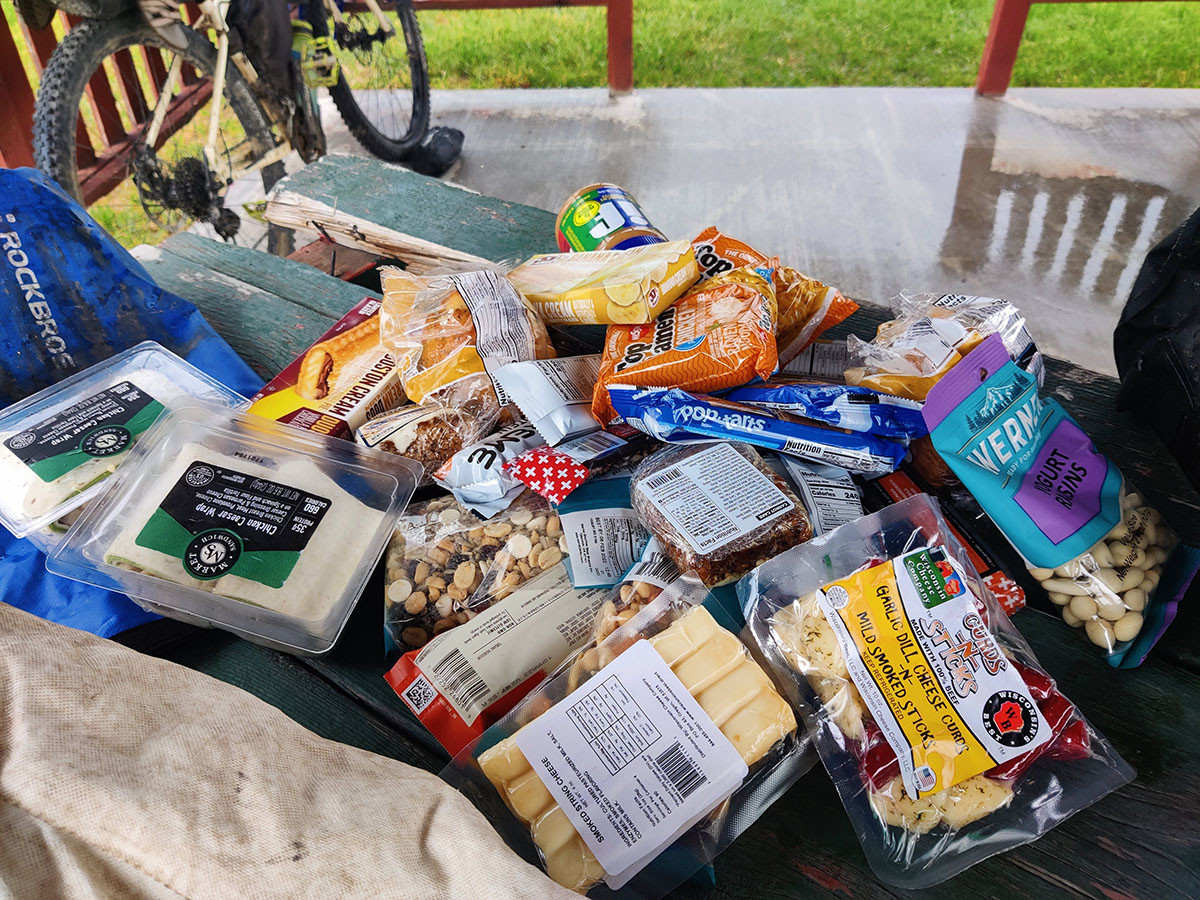 A couple dozen packages of gas station treats – everything from wraps to Pop Tarts – lays spread on an outdoor picnic table.
A couple dozen packages of gas station treats – everything from wraps to Pop Tarts – lays spread on an outdoor picnic table.
Stocking up at a gas station along the route
Alissa Bell
The Art of Light Packing for the Great Divide Bike Route: Gear Essentials
One sunny, slightly hazy afternoon in Wyoming, I encountered two southbound riders within a few hours. One was sporting ultralight racing gear, almost resembling a day rider. The other was navigating with four fully loaded panniers. Both, at that moment, were smiling. It seems the Great Divide bike route can be ridden with almost any gear configuration.
My own approach – a lightweight-ish gear list packed into a soft-bag bikepacking setup – appeared to be a common compromise. I also observed numerous rear racks with smaller panniers, or simple dry sacks and rubber straps. Fully loaded four-pannier setups were less frequent, and some of these riders opted for paved alternates around the most challenging sections, but they still seemed to be enjoying their ride. If you choose to use a rack on your Great Divide bike tour – a perfectly reasonable choice – ensure it’s robust and apply threadlocker to the bolts to prevent loosening on rough terrain.
The primary advantage of a bikepacking-style gear setup might be the inherent limitation of space. The rationale for packing light becomes self-evident on the steep ascents of the Gila, the high passes of the San Juans, and the demanding trails of Montana. Yet, evenings at camp, ideally in relative comfort, are also a crucial part of the experience. The enduring quest for the human-powered traveler remains: carry everything you need and need (or truly enjoy) everything you carry.
Especially if the Divide is your first long-haul ride, discerning essential gear from superfluous items can be challenging. Fortunately, adjustments can be made en route. If an item remains unused for a week and is not intended for anticipated future conditions, consider mailing it home from the next post office. Post offices are present in every town and offer boxes and tape for sale. Simply arrive with your unwanted items and depart a few pounds lighter.
Similarly, if you are hesitant about packing a “nice-to-have” item, leave it with a friend. You will likely forget about it once you start riding, but if you do need it, they can mail it to you via General Delivery. An even better option is to contact a business along your route (RV park, hostel, general store) and inquire if they will hold a package for you; their hours are often more flexible than the local post office. This strategy also works well for sending resupply packages of specialized food or other consumables to yourself along the way.
Before packing or mailing every conceivable item you might need, remember that you are not venturing into uninhabited wilderness. You will pass through a small town every three to four days at most, often more frequently, and larger towns or cities every week or two. Food, toiletries, laundromats, bike parts, and even outdoor gear are readily available, especially if you are not overly particular.
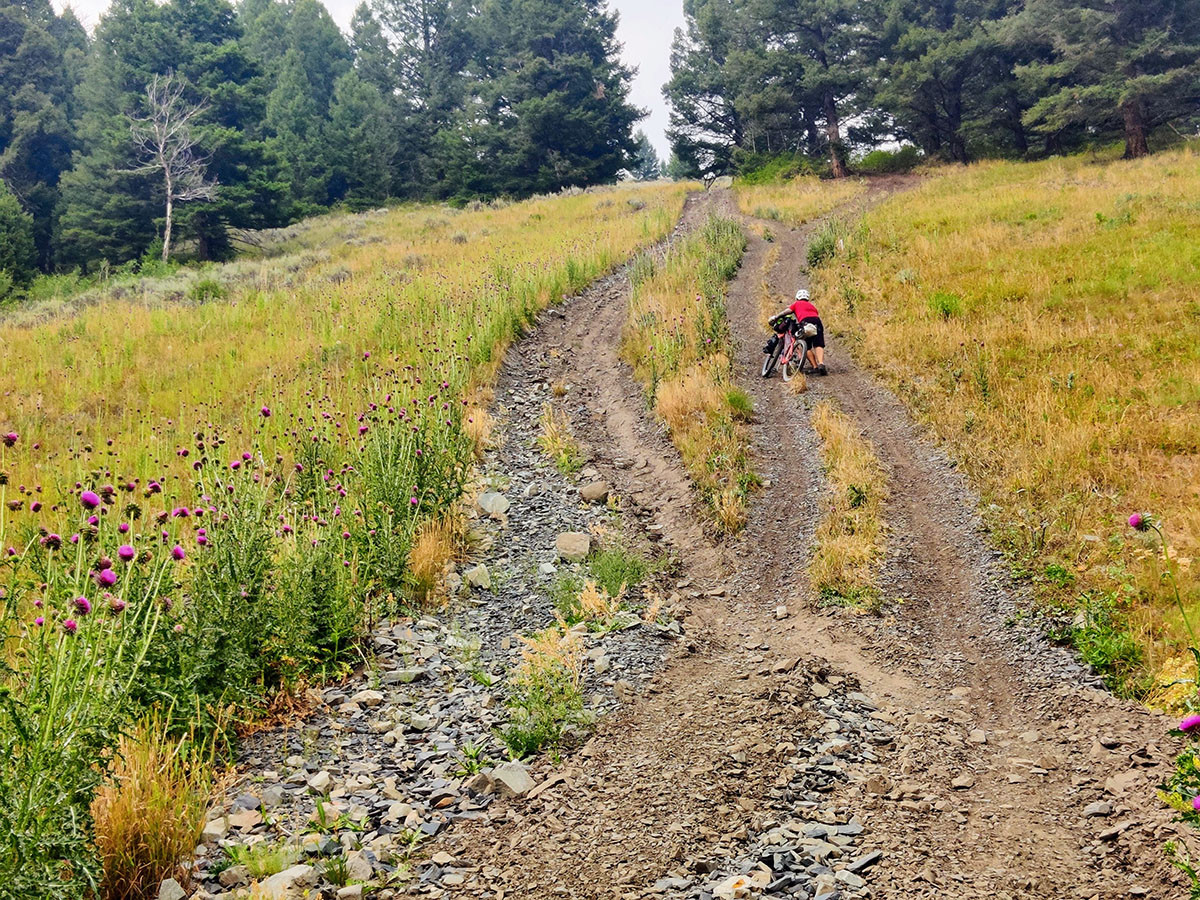 Alissa
Alissa
Getting friendly with a hike-a-bike on Fleecer Ridge in Montana
Alissa Bell
Navigating Towns and Embracing Wilderness on the Great Divide Bike Route
After days immersed in nature, the prospect of rolling into a small town oasis is immensely appealing. A restaurant and motel – and, heaven-sent, a grocery store! – can feel like the only necessities in life.
This is the allure of the “town vortex.” Whether it’s the physical comfort, social interaction, or the sense of accomplishment in reaching a waypoint, or simply the anticipation of good food, it can be challenging to break away from a pleasant town once chores are completed. Consequently, many riders on the Great Divide bike route hop from town to town, arriving in the late afternoon and succumbing to the temptation of a comfortable motel for the night.
While there is nothing wrong with enjoying motel comforts – I personally appreciate them greatly – I suggest an approach that served me well: try, at least occasionally, to ride through towns and camp outside them. If you plan to arrive in town mid-day and mentally prepare to depart by mid-afternoon (after a satisfying lunch, naturally), resisting the vortex becomes easier. This approach also significantly reduces expenses. A motel room can easily cost $120 or more in some towns, and securing one at the last minute can be stressful.
Leaving many towns along the Great Divide bike route, you can access public land within ten to twenty miles. The GDMBR traverses a wealth of National Forest land, ideal for free camping, and I spent roughly half of my nights on the Divide taking advantage of this. Some nights were dictated by necessity – no towns within reach – but many were by choice. Opportunities abound throughout the route, but northern New Mexico and the national forests of Colorado were particularly delightful for their frequent, scenic, and grizzly-free camping options.
On a more subjective note, increased camping can significantly alter the rhythm of your ride. For some, the bustle of towns can feel overwhelming after prolonged periods of solitude. By listening to your mind and body, you can utilize camping as a tool to establish your own rhythm. Town luxuries become even more appreciated after a few nights in the wild, and a tranquil night under the stars can be particularly rewarding after town days.
 Alissa
Alissa
The perfect dispersed campsite in New Mexico
Alissa Bell
Wild Camping on the Great Divide Bike Route: Finding Your Perfect Campsite
Dispersed camping, also known as wild camping, is among my preferred camping styles. It offers greater tranquility than organized campgrounds, more flexibility in daily mileage, and is completely free. Despite the absence of amenities like picnic tables and toilets, I almost always prefer a quiet night of dispersed camping over a busy campground.
Initially, I anticipated utilizing the small brown tent icons marked “informal campground” on the Adventure Cycling GPX data for dispersed camping. However, these often turned out to be large dirt pullouts, sometimes occupied by RVs and occasionally littered with broken glass. I soon realized these sites are primarily intended for RVs and car campers, and cyclists can find far better options. An “informal campground” marker signifies public land – either National Forest or Bureau of Land Management – where dispersed camping is permitted. If the designated spot is unappealing, chances are a more suitable alternative exists nearby.
Especially when riding solo on the Great Divide bike route, my key to a restful night is campsite concealment from the road. While most people are well-intentioned, my primal instincts are strong. I sleep more soundly when I don’t have to wonder at 2 AM if a passing truck driver noticed my tent. Therefore, I seek secluded spots – atop a small hill, within a shallow ravine, or deep within sparse trees off a faint doubletrack – and relish the feeling of blending into the natural environment for the night. If concealment is challenging, camping on the inside of curves and uphill from the road is a helpful tactic, minimizing exposure to passing headlights.
A crucial reminder, undoubtedly familiar: Leave No Trace principles are paramount for this type of camping. This includes pitching your shelter on durable surfaces like dirt or pine needles rather than vegetation, forgoing campfires if a fire ring isn’t present or a fire ban is in effect, packing out all trash and food waste, and digging a proper 8-inch deep cathole if toilet facilities are unavailable. Given that much of the Great Divide bike route is in bear habitat, employing bear-aware camping practices is also essential.
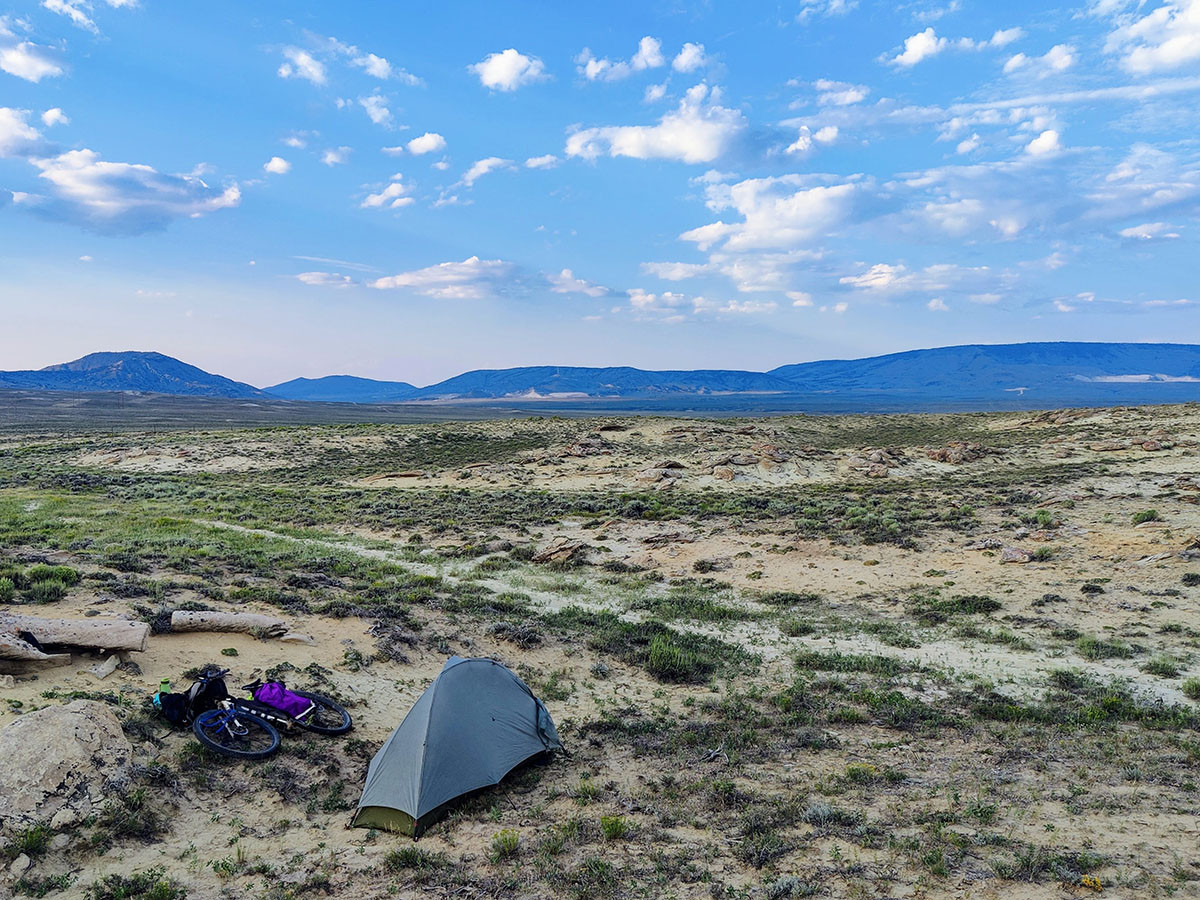 Alissa
Alissa
Dispersed camping in the Great Basin of Wyoming
Alissa Bell
Adapt and Thrive: Just-in-Time Planning for the Great Divide Bike Route
The GDMBR is a constantly evolving tapestry of roads, communities, and landscapes. This continuous variation maintains interest over thousands of miles but also necessitates careful attention. Twice-daily restaurants will transition to stretches requiring three-day food carries (and vice versa), abundant water sources will eventually give way to the route’s longest dry section (hint: it’s not the Basin), and ample camping opportunities can abruptly vanish into extended sections of private land. Just when you think you have established a routine, the route will surprise you.
The most valuable advice I can offer is to embrace just-in-time planning. Meticulously planning every day in advance would be both frustrating and ultimately futile, but neglecting preparation for upcoming conditions is equally unwise. Even seasoned riders need to periodically remind themselves of this balance. To structure this process, consider these questions during each town stop or shortly beforehand:
- How many days until the next resupply point, and are there any restaurants in between?
- How far to the next reliable water source, and are any particularly long water carries ahead?
- What are promising potential campsites for the next couple of nights, and are there any lengthy sections of private land to be aware of?
- What is the current weather forecast?
- Are there any route closures or detours in the upcoming section?
- If a motel stay in the next town is desired, is advance booking advisable due to demand?
Just-in-time planning is essential while on the road, but smart gear choices before departure are equally important. Crucially, you will need a flexible cargo system with variable capacity for food and water. Typically, I carried one to two days of food, but extended this to four days in northern New Mexico. Two liters of water sufficed in most areas, but I carried six liters in the Great Basin and a challenging eight liters in the Gila National Forest south of Pie Town, NM. Specific needs will depend on your pace, direction, and seasonal conditions, but all riders will encounter fluctuating resupply requirements throughout the Great Divide bike route.
Numerous strategies exist to manage this variability, but my approach involved two 5L dry bags strapped to gear cages on my fork. These could be fully packed with food and water when necessary and compressed to near-invisibility when not needed. Additional water capacity came from two collapsible Platypus bottles and the 3L dirty bag from my water filter system. For times when managing bike-mounted cargo became cumbersome, I carried a very useful small stuffable backpack.
While these changing conditions kept me mentally engaged, there was also an element of emotional liberation. Weather, terrain, and my own mood fluctuated from day to day and mountain pass to mountain pass. Just as a perfect, easy day could transition into a challenging one, every challenge invariably resolved itself. The more I learned to relax into the rhythm of the ride, the greater my sense of well-being.
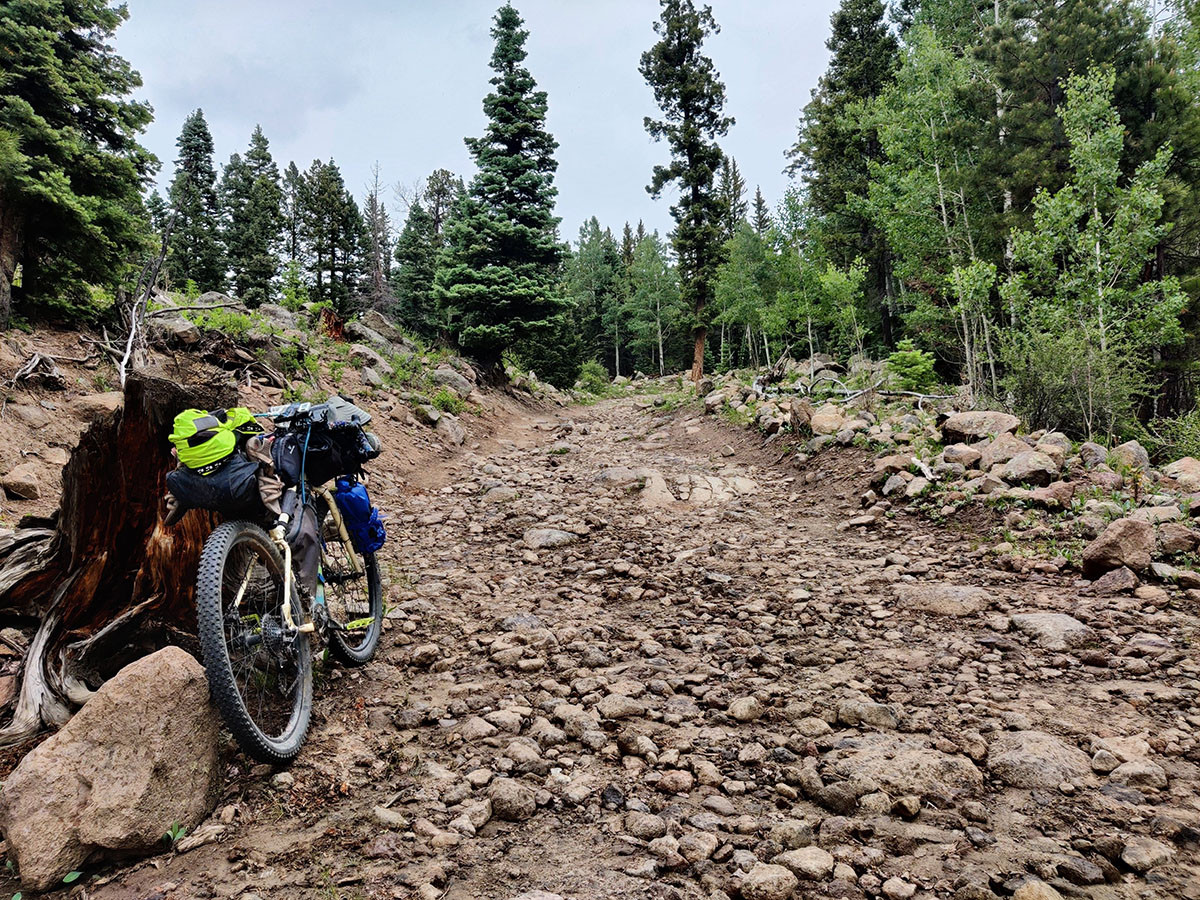 Alissa
Alissa
A rough road south of Abiquiu, New Mexico, makes for slow travel.
Alissa Bell
Final Tips
Here are a few more practical tips to tuck away for your GDMBR adventure.
Keep a daily journal and take photographs, and remember to include people you meet and places you stay, not just scenic vistas. The early days on the Divide feel indelible, but after several weeks, they tend to blur together.
Maximize opportunities for healthy food. In certain sections of the Great Divide bike route, gas station fare will be your primary sustenance for days. Even delicious town meals can lose their appeal after a while. When you encounter a well-stocked grocery store, check in with your body’s cravings. You might be surprised to find a large, crisp salad is exactly what you desire!
Take advantage of cyclist-specific lodging and camping. Iconic locations along the Divide – Toaster House, Brush Mountain Lodge, Llama Farm, among others – are renowned for their hospitality and the sense of community they cultivate. Many of my most meaningful connections and conversations occurred at these gathering places. Even when initially tempted to bypass the social scene and camp alone, I always left feeling rejuvenated and grateful for having stopped.
Embrace hike-a-bike. There is no shame in dismounting and walking on a route like the Great Divide bike route. Walking and pushing your bike up a steep incline that is barely pedalable is a smart strategy to conserve energy, prevent overuse injuries, and engage different muscle groups and joints.
Stay informed about current route conditions. The GDMBR traverses vast stretches of wilderness, and conditions can change rapidly. Active Facebook groups are valuable resources for real-time information on water sources, fire closures, trail magic, lost and found gear, and various other helpful insights. Also, regularly check the Adventure Cycling Association addenda for route detours and updates to services listed on maps.
Above all, try to minimize stress! Riding such a well-documented route can create the impression that you should have all the answers and execute flawlessly from the outset. I encourage you to absorb as much information as you find helpful or enjoyable for both planning and inspiration, but don’t feel pressured to implement every piece of advice. After all, having everything perfectly figured out from the start would diminish the adventure!
There is a unique and profound feeling in mounting your bike, pointing your wheels towards a distant international border, and beginning to pedal. As a naturally resilient and resourceful human being, you can be confident in your ability to navigate whatever lies ahead. May the wind be at your back, the air clear and crisp, and the climbs gentle. And even when these conditions are not met, may you still discover confidence, contentment, and community on the Great Divide.

